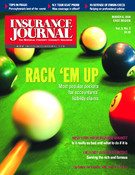While some believe government action may be necessary to keep New York’s homeowners insurance market from falling into a crisis, others note that the state’s public policy already incorporates a number of protections for consumers and private incentives.
The biggest safety net is the New York Property Insurance Underwriting Authority, the state’s market of last resort. Kristina Baldwin, regional manager for the Property Casualty Insurers of America, notes that the NYPIUA’s role has been enhanced with the state’s approval of “wrap around” coverage, which allows homeowners to receive fire and extended coverage through NYPIUA and liability, theft and other coverages from a voluntary insurer.
New York public policy also provides for a mandatory three-year renewal on homeowners business, according to New York Insurance Association Inc.’s Bernie Bourdeau. “That policy serves to stabilize the market against sudden shifts in company strategies,” he suggested.
The state permits a wide variety of windstorm deductibles and recently authorized multi-tier rating programs for homeowners.
Agents are more inclined than insurers to welcome government involvement. Top on their list is legislation making the NYPIUA permanent, instead of subject to annual legislative reauthorization.
The Independent Insurance Agents & Brokers of New York, thinks the state should let insurers use computerized catastrophe models to determine rates. “These models have been used successfully in Florida and will help to stabilize the market and insure that fair and adequate rates are being charged,” said IIABNY’s Mark Hagan.
N. Stephen Ruchman, past president, the Professional Insurance Agents of New York, hopes the insurance department will try to persuade Allstate to reconsider, arguing that the customers dropped will likely be those who have had a claim or who live closest to the water. He worries more may be non-renewed than the existing market can absorb.
If government is called, more might be accomplished at the federal than state level. For instance,
Ruchman notes that the $250,000 coverage limit for the National Flood Insurance Program was set in 1968 and claims the entire program needs updating.
IIABNY supports a multi-state, multi-peril catastrophe fund, since a fund supported by New York state alone would not suffice. “There would not be enough spread of risk due to the geography of our state, and with the political controversy surrounding these kinds of funds, it is unlikely that a catastrophe fund would provide any short term relief,” according to Hagan.
PIANY also urge caution about about any cat fund, especially at the state level. “We believe the first focus should be on federal tax policy, so that insurers individually could create additional catastrophe reserves for low-frequency, high-severity events,” says Ruchman.
Several parties point to the Coastal Market Assistance Program, which was begun in the wake of Hurricane Andrew in 1992, as a possible answer should availability become a problem. It is a network of insurers and producers who assist coastal homeowners in obtaining insurance.
NYSIA’s Bourdeau suggests that if problems arise, they could be solved by private markets if government does not overreact now.
“Companies today are poised to capture the market share being conceded by their competitors,” says Bourdeau. “The worst thing that could happen at this point would be a government reaction, by legislation or regulation, that is perceived by these companies as restricting their ability to manage their business. That would reduce the flow of new capacity to the coastal market, the very thing that is most needed at this time.”
Was this article valuable?
Here are more articles you may enjoy.


 As Rates Rise, Majority of Homeowners Say Insurance Industry Is in Crisis: Survey
As Rates Rise, Majority of Homeowners Say Insurance Industry Is in Crisis: Survey  Zurich to Buy AIG’s Travel Insurance Business for $600 Million
Zurich to Buy AIG’s Travel Insurance Business for $600 Million  Coverage Needed: Hundreds of Thousands in SE Now in Flood Zones With New Maps
Coverage Needed: Hundreds of Thousands in SE Now in Flood Zones With New Maps  Three Charged With Helping Agents Cheat on Florida Insurance License Exams
Three Charged With Helping Agents Cheat on Florida Insurance License Exams 


